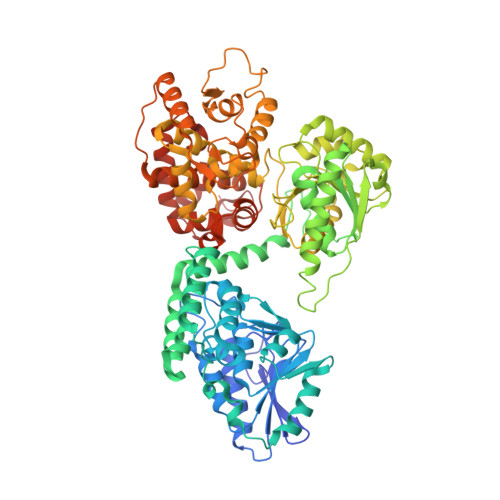The Isomerase and Hydratase Reaction Mechanism of the Crotonase Active Site of the Multifunctional Enzyme (Type-1), as Deduced from Structures of Complexes with 3S-Hydroxy- Acyl-Coa.
Kasaragod, P., Schmitz, W., Kalervo Hiltunen, J., Wierenga, R.K.(2013) FEBS J 280: 3160
- PubMed: 23351063
- DOI: https://doi.org/10.1111/febs.12150
- Primary Citation of Related Structures:
3ZW8, 3ZW9, 3ZWA, 3ZWB, 3ZWC - PubMed Abstract:
The multifunctional enzyme, type-1 (MFE1) is involved in several lipid metabolizing pathways. It catalyses: (a) enoyl-CoA isomerase and (b) enoyl-CoA hydratase (EC 4.2.1.17) reactions in its N-terminal crotonase part, as well as (3) a 3S-hydroxy-acyl-CoA dehydrogenase (HAD; EC 1.1.1.35) reaction in its C-terminal 3S-hydroxy-acyl-CoA dehydrogenase part. Crystallographic binding studies with rat peroxisomal MFE1, using unbranched and branched 2E-enoyl-CoA substrate molecules, show that the substrate has been hydrated by the enzyme in the crystal and that the product, 3S-hydroxy-acyl-CoA, remains bound in the crotonase active site. The fatty acid tail points into an exit tunnel shaped by loop-2. The thioester oxygen is bound in the classical oxyanion hole of the crotonase fold, stabilizing the enolate reaction intermediate. The structural data of these enzyme product complexes suggest that the catalytic base, Glu123, initiates the isomerase reaction by abstracting the C2-proton from the substrate molecule. Subsequently, in the hydratase reaction, Glu123 completes the catalytic cycle by reprotonating the C2 atom. A catalytic water, bound between the OE1-atoms of the two catalytic glutamates, Glu103 and Glu123, plays an important role in the enoyl-CoA isomerase and the enoyl-CoA hydratase reaction mechanism of MFE1. The structural variability of loop-2 between MFE1 and its monofunctional homologues correlates with differences in the respective substrate preferences and catalytic rates.
Organizational Affiliation:
Biocenter Oulu and Department of Biochemistry, University of Oulu, Oulu, Finland.

















